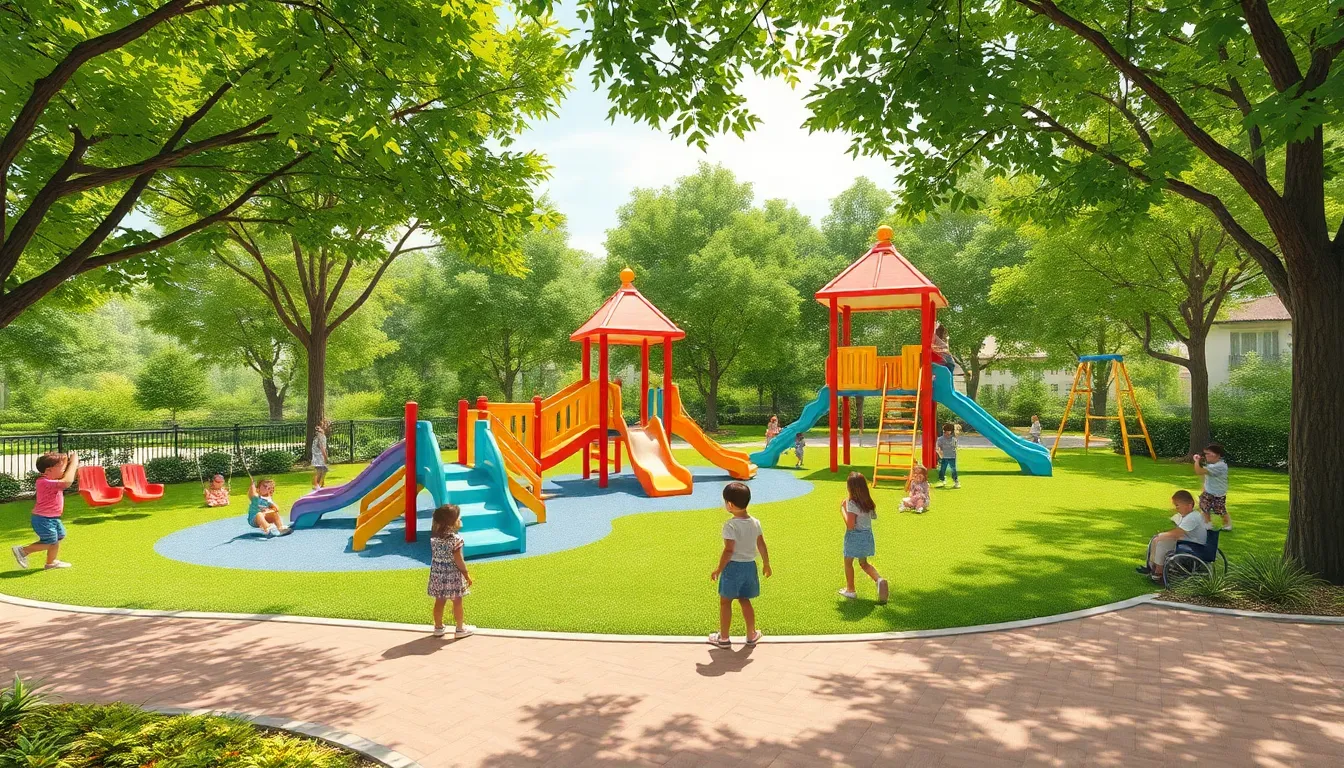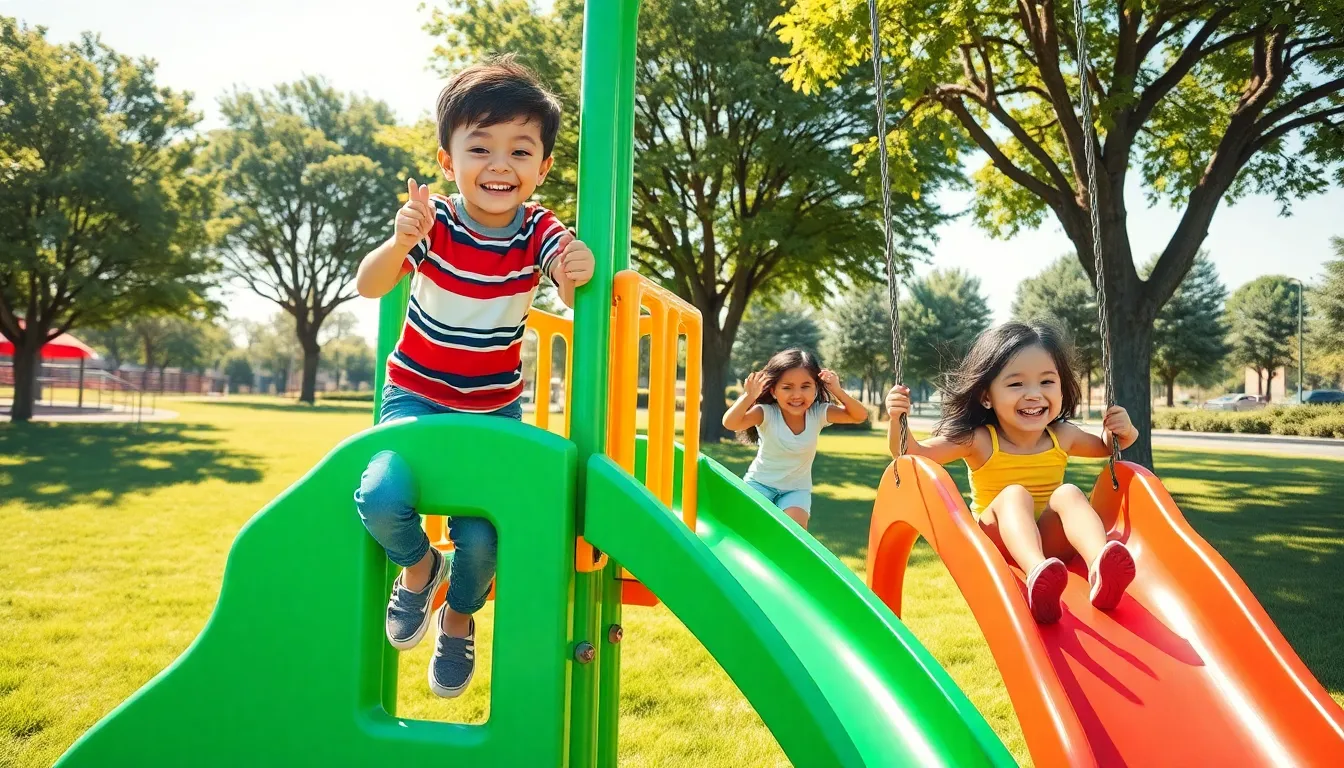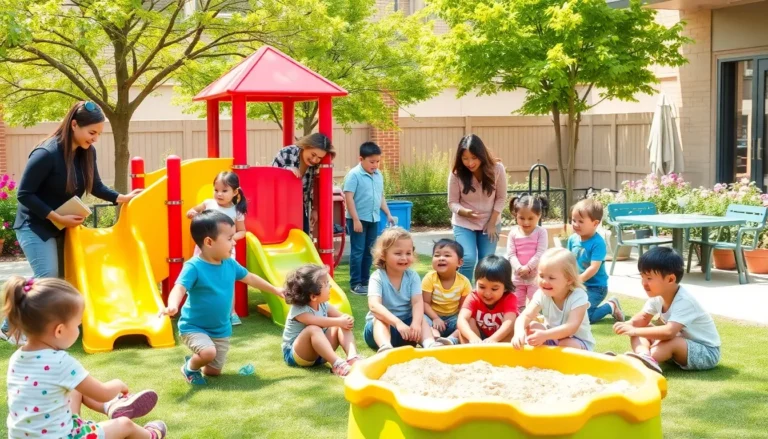When it comes to early childhood development, outdoor play spaces are the secret sauce every parent and educator needs. Imagine a world where kids transform into mini explorers, scaling mountains made of mulch and conquering the jungle gym like it’s Mount Everest. These vibrant playgrounds aren’t just about swings and slides; they’re crucial for physical, social, and emotional growth.
Let’s face it: kids are like little sponges, soaking up everything around them. Outdoor play spaces provide the perfect backdrop for them to learn teamwork while dodging imaginary dragons or racing to the finish line. So why settle for indoor playrooms when the great outdoors offers endless adventures? Dive into the world of outdoor play spaces and discover how they can turn your child’s playtime into a fun-filled learning experience.
Table of Contents
ToggleImportance Of Outdoor Play Spaces In Early Childhood
Outdoor play spaces play a crucial role in early childhood development. These environments facilitate various physical, social, and emotional growth opportunities.
Benefits Of Outdoor Play
Outdoor play enhances children’s physical health by promoting activity. Engaging in physical movement supports cardiovascular fitness and muscle strength. Social interactions occur naturally in these settings, fostering communication and teamwork. Emotional resilience develops as children navigate challenges in play, leading to improved self-esteem. Creativity flourishes in an unstructured outdoor environment, allowing children to explore their imaginations freely. The variety of experiences provided outdoors contributes to well-rounded development.
Developmental Milestones Supported By Outdoor Play
Outdoor play aligns closely with key developmental milestones. Gross motor skills improve as children climb, run, and jump. Fine motor skills also get refined through activities like digging and building. Social skills strengthen through collaborative games, inspiring cooperation and conflict resolution. Cognitive growth benefits from exploration and sensory experiences in nature, promoting curiosity and problem-solving. Emotional development progresses as children manage feelings while playing with peers, leading to greater emotional intelligence. Each milestone supported by outdoor play ultimately contributes to healthy childhood development.
Designing Effective Outdoor Play Spaces

Creating effective outdoor play spaces requires thoughtful planning and consideration. These environments should encourage exploration and foster social interactions among children.
Key Elements Of Outdoor Play Areas
Diverse play equipment engages children of varying ages and interests. Incorporating climbing structures, swings, and slides offers opportunities for physical activity. Natural elements like trees, grassy areas, and gardens enhance sensory experiences and promote imaginative play. Additionally, accessible paths enable all children, including those with disabilities, to actively participate. Incorporating shaded areas protects children from sun exposure, promoting comfort during playtime.
Safety Considerations
Ensuring safety is vital in outdoor play space design. Using age-appropriate equipment minimizes the risk of injury. Soft materials like rubber mulch or grass cushioning under play structures help prevent falls. Regular maintenance checks identify wear or potential hazards, ensuring the play area remains secure. Clearly defined boundaries keep children within designated play zones. Furthermore, providing adult supervision enhances safety by monitoring interactions and behaviors during play.
Types Of Outdoor Play Spaces For Young Children
Outdoor play spaces come in various forms, each designed to support children’s growth through diverse experiences. These environments allow for exploration, creativity, and socialization among peers.
Nature-Based Playgrounds
Nature-based playgrounds emphasize natural elements, such as trees, rocks, and water features. These spaces encourage children to engage with their surroundings, enhancing sensory experiences. Climbing trees or navigating logs fosters physical coordination while promoting imaginative play. Such environments also facilitate social interactions among children as they participate together in unstructured games. Opportunities for environmental learning arise when children observe wildlife or learn about plants. Natural playgrounds cater to various age groups, ensuring that young children connect with nature and develop critical skills.
Community Parks And Gardens
Community parks and gardens serve as inclusive spaces for outdoor play and social activities. These areas often feature play equipment, open fields for running, and serene gardens for exploration. Engaging in sports or group activities cultivates teamwork and physical health. Parks typically welcome families, fostering a sense of community through shared experiences. Gardens promote hands-on learning about nature, where children can plant seeds or observe growth cycles. Accessible to all, community parks and gardens become vital resources for promoting mental well-being and fostering interpersonal relationships among young children.
Incorporating Learning Into Outdoor Play
Outdoor play spaces provide excellent opportunities for blending learning with fun. Children engage in activities that stimulate their minds while developing essential skills.
Educational Play Structures
Educational play structures are designed to enhance children’s learning experiences. These structures often incorporate elements that promote problem-solving and critical thinking. For instance, climbing walls and balance beams encourage physical coordination and spatial awareness. Additionally, themed play areas, such as a pirate ship or a castle, spark imaginative play while inspiring storytelling. Including interactive panels featuring shapes, numbers, or letters fosters literacy and numeracy skills during playtime. By combining physical activity with cognitive challenges, these structures play a crucial role in a child’s overall development.
Creating Interactive Learning Stations
Creating interactive learning stations transforms outdoor spaces into hubs of exploration. Each station can focus on different subjects, such as science, art, or nature. For example, a garden station might allow children to plant seeds, facilitating hands-on learning about life cycles and ecology. An art station can offer materials for creative expression, encouraging artistic skills alongside fine motor development. Incorporating sensory tables filled with natural materials stimulates curiosity and exploration. Through these interactive stations, children gain knowledge while enjoying outdoor play, reinforcing connections between education and active engagement with their environment.
Investing in outdoor play spaces for early childhood is essential for nurturing healthy development. These environments not only promote physical activity but also encourage social interactions and emotional growth. By providing diverse play opportunities and natural elements, children can explore their surroundings while building critical skills.
Thoughtfully designed outdoor spaces create a sense of community and belonging, making them invaluable for young children and their families. It’s clear that prioritizing outdoor play can significantly enhance early childhood experiences, paving the way for well-rounded individuals ready to take on the world.




